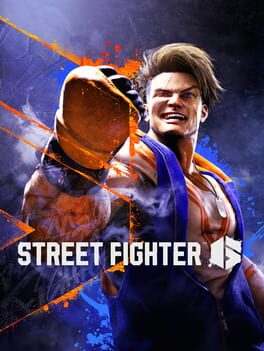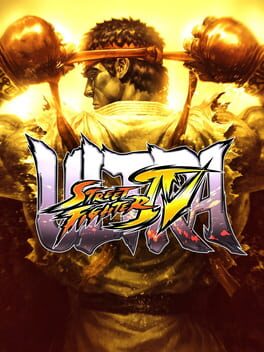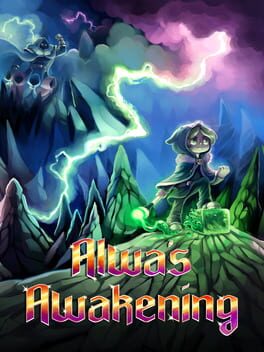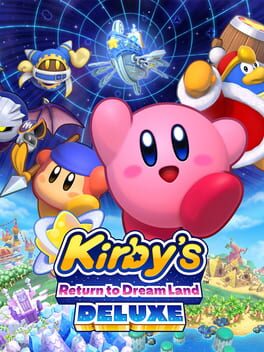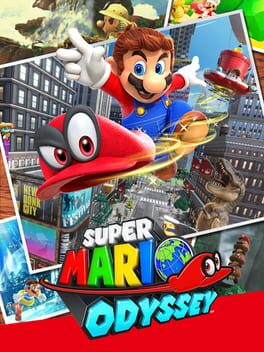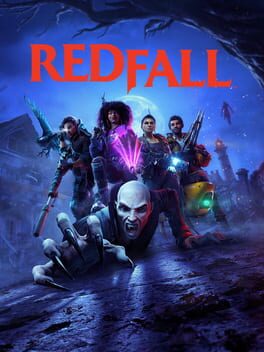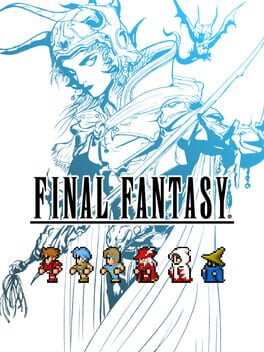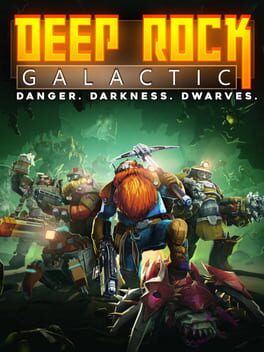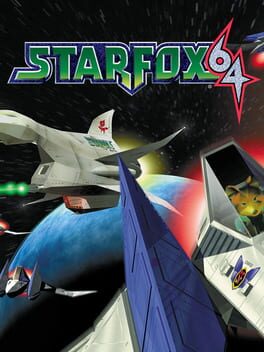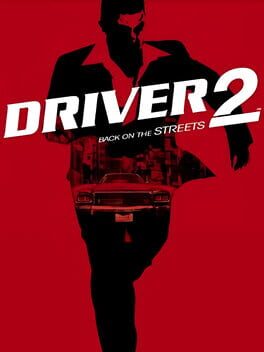taigamask
31 Reviews liked by taigamask
Street Fighter 6
2023
It's no secret that Mortal Kombat: Deception's Konquest Mode is one of my favorite parts of any fighting game. If you didn’t know that, you should have, but now it certainly isn't a secret.
From Shenmue to Hybrid Heaven, the illusive 1v1 fighting game/RPG is something I've been chasing for a while, and the day has finally arrived that I can say hello to the official ambassador for my beloved micro-genre. But it seemed unfortunate that such a Concept™, a Conmancept if you will, had to get its defining moment in a franchise I usually avoid. Street Fighter V didn't even launch with an arcade mode.
World Tour got me in the door, but the surprise of Street Fighter 6 is how it now has me hooked on Street Fighter gameplay. I know, truly shocking that someone who enjoys oft-derided Mortal Kombat games would see the light after experiencing kino.
My esteemed and beautiful backloggd family, I've even been playing a fighting game... online. Normally this bald boy can't make it through a single online match in MK or Tekken without ending up drenched in sweat, but starting out as such a noobie in SF I felt less pressure and therefore less critical of myself. I've spent way more time in the Battle Hub than I anticipated. The Conman has even played the daunting ranked matches (I'm only currently Bronze with Guile but I started at Iron and this is basically the first SF I've ever gotten into). I've played loads of the practice modes and combo trials, and I'm just having a blast learning and slowly getting better at the game.
This has gotta be, without a doubt, the best entry point to Street Fighter. The single player RPG campaign allows you to get to grips with the mechanics (I chose classic controls) and introduces you to the world and characters, allowing you to familiarize yourself with them and pick a main. Guile actually controls the least like the characters I'm used to in games because charge attacks are simply not part of my muscle memory, but something about him stuck and I'm in. What's even crazier is that retroactively this game has helped me break down my barrier to the other SF games: Street Fighter Alpha 2 is fire, which I discovered because it’s available to play periodically in the Battle Hub.
This is a content-rich and beginner friendly experience and I highly recommend it. For the first time ever I'm seriously doubting that the new Mortal Kombat and Tekken are going to live up to a freaking Street Fighter game in terms of personal appeal to me, a guy who hasn't even played 3rd Strike. While still based and Conmanpilled, World Tour feels slightly underdeveloped in a few areas such as the generic story, lack of environment/enemy variety, and artificial difficulty, so it can and should be expanded upon in future entries. Every fighting game should straight-up copy this. NRS, stop whatever you're doing and make Konquest 2. I saw the Krypt from 11, you know you want to.
I'm such a sucker I even went to Chipotle to get fighter points, but they didn’t just give me a tier-skip or whatever, it was enough points to get the entire fighter pass. Completing said fighter pass got me enough to get the subsequent pass. The passes also all include a retro Capcom game.
From Shenmue to Hybrid Heaven, the illusive 1v1 fighting game/RPG is something I've been chasing for a while, and the day has finally arrived that I can say hello to the official ambassador for my beloved micro-genre. But it seemed unfortunate that such a Concept™, a Conmancept if you will, had to get its defining moment in a franchise I usually avoid. Street Fighter V didn't even launch with an arcade mode.
World Tour got me in the door, but the surprise of Street Fighter 6 is how it now has me hooked on Street Fighter gameplay. I know, truly shocking that someone who enjoys oft-derided Mortal Kombat games would see the light after experiencing kino.
My esteemed and beautiful backloggd family, I've even been playing a fighting game... online. Normally this bald boy can't make it through a single online match in MK or Tekken without ending up drenched in sweat, but starting out as such a noobie in SF I felt less pressure and therefore less critical of myself. I've spent way more time in the Battle Hub than I anticipated. The Conman has even played the daunting ranked matches (I'm only currently Bronze with Guile but I started at Iron and this is basically the first SF I've ever gotten into). I've played loads of the practice modes and combo trials, and I'm just having a blast learning and slowly getting better at the game.
This has gotta be, without a doubt, the best entry point to Street Fighter. The single player RPG campaign allows you to get to grips with the mechanics (I chose classic controls) and introduces you to the world and characters, allowing you to familiarize yourself with them and pick a main. Guile actually controls the least like the characters I'm used to in games because charge attacks are simply not part of my muscle memory, but something about him stuck and I'm in. What's even crazier is that retroactively this game has helped me break down my barrier to the other SF games: Street Fighter Alpha 2 is fire, which I discovered because it’s available to play periodically in the Battle Hub.
This is a content-rich and beginner friendly experience and I highly recommend it. For the first time ever I'm seriously doubting that the new Mortal Kombat and Tekken are going to live up to a freaking Street Fighter game in terms of personal appeal to me, a guy who hasn't even played 3rd Strike. While still based and Conmanpilled, World Tour feels slightly underdeveloped in a few areas such as the generic story, lack of environment/enemy variety, and artificial difficulty, so it can and should be expanded upon in future entries. Every fighting game should straight-up copy this. NRS, stop whatever you're doing and make Konquest 2. I saw the Krypt from 11, you know you want to.
I'm such a sucker I even went to Chipotle to get fighter points, but they didn’t just give me a tier-skip or whatever, it was enough points to get the entire fighter pass. Completing said fighter pass got me enough to get the subsequent pass. The passes also all include a retro Capcom game.
Alwa's Awakening
2017
There's two things a throwback platformer needs to do to get things right.
The first is the jump. How's it feel? Does it work, fit the game's needs? I'm happy to say that Alwa's jump is perfect. She does the thing, the little stiff-legged, feet together thing. At the apex her arms come out a bit, her feet kick forward. Perfect, timely delivery, product was in great condition.
Everything else is just icing on the cake. The art? Spot on, feels like NES, runs on NES. The music? A genuine highlight, great use of leitmotifs, never abrasive. How's the challenge? It's good, chill. Nothing too hard, most enemies are there to challenge you to one cycle a screen instead of waiting on patterns, puzzles tend to stay solved so backtracking doesn't become a chore. Warp points are in good spots, on that note, and exploration is worthwhile, with upgrades coming in both substantial boosts and incremental initial damage to bosses. Good stuff, good times, controls well. What more could you ask for?
Well. It's not perfect. The menu confirm is not the same as the game confirm, for example. Absolute hell, what were they thinking. Alwa gets most of her mobility from spells, so overall she feels a bit slow. Fits the pace of the game, though, and even with extra exploration it's never really an issue. Those incremental orb upgrades hit a brick wall once you hit 50% collected, requiring the final half to get the final boost. It doesn't really matter, but it's a bit odd. Speaking of, item% doesn't include those orbs, which is certainly a choice.
Still: solid little game, even more solid platform for the rather nice looking sequel. Tons of room to grow, in all the best ways.
Oh, the second thing. A good throwback game needs a name that causes confusion when it comes to the main character. It's Zoe, not Alwa. Arkista and Zelda send their regards.
The first is the jump. How's it feel? Does it work, fit the game's needs? I'm happy to say that Alwa's jump is perfect. She does the thing, the little stiff-legged, feet together thing. At the apex her arms come out a bit, her feet kick forward. Perfect, timely delivery, product was in great condition.
Everything else is just icing on the cake. The art? Spot on, feels like NES, runs on NES. The music? A genuine highlight, great use of leitmotifs, never abrasive. How's the challenge? It's good, chill. Nothing too hard, most enemies are there to challenge you to one cycle a screen instead of waiting on patterns, puzzles tend to stay solved so backtracking doesn't become a chore. Warp points are in good spots, on that note, and exploration is worthwhile, with upgrades coming in both substantial boosts and incremental initial damage to bosses. Good stuff, good times, controls well. What more could you ask for?
Well. It's not perfect. The menu confirm is not the same as the game confirm, for example. Absolute hell, what were they thinking. Alwa gets most of her mobility from spells, so overall she feels a bit slow. Fits the pace of the game, though, and even with extra exploration it's never really an issue. Those incremental orb upgrades hit a brick wall once you hit 50% collected, requiring the final half to get the final boost. It doesn't really matter, but it's a bit odd. Speaking of, item% doesn't include those orbs, which is certainly a choice.
Still: solid little game, even more solid platform for the rather nice looking sequel. Tons of room to grow, in all the best ways.
Oh, the second thing. A good throwback game needs a name that causes confusion when it comes to the main character. It's Zoe, not Alwa. Arkista and Zelda send their regards.
This is pretty much pure, basic, unfiltered Kirby. There's little bells and whistles to the formula. It won't bring in anyone not a fan of Kirby and won't turn anyone away who is a fan.
There are the ultra powers, or whatever they're called. Supped up copy abilities that can be found in specific stages and essentially exist just to smash everything on screen for 3 minutes and unlock a secret portal to an auto-scrolling platform challenge, followed by a fight with a mini-boss for two of this games obligatory collectibles.
These power moments provide some brief fun, but like the mega mushrooms in New Super Mario Bros. there's only so much you can do with a gimmick whose entire thing is hulk smashing everything.
The mini-game compilation is pretty fun. Of course the real draw of the mode is multiplayer, but they provide lots of encouragement for solo players to try it out, with a challenge list and unlockable cosmetics + items to use in the main game.
What I didn't quite get was why the entire mini-game catalogue opened up straight after beating level 2, then one of the bonuses for collecting the previously mentioned collectibles was unlocking mini-games in the games hub area. I can only assume this was a leftover from the original game where mini-games had to be slowly unlocked?
As a Kirby game you can expect it to be short and easy, but as usual post-game provides both a little longevity and a lot of challenge for 100%. There's "extra" mode, which is literally just the whole game again but basically hard mode. I'm not a big fan of difficulty options that are disguised as unlockables, especially when there's no option to select default difficulty in the first place.
Magolor's Epilogue provides a pretty cool alternate-gameplay journey. Being very combo and upgrade focused as opposed to Kirby's switch-and-swap abilities
And of course you've got your boss rush mode.
All in all, it's Kirby.
There are the ultra powers, or whatever they're called. Supped up copy abilities that can be found in specific stages and essentially exist just to smash everything on screen for 3 minutes and unlock a secret portal to an auto-scrolling platform challenge, followed by a fight with a mini-boss for two of this games obligatory collectibles.
These power moments provide some brief fun, but like the mega mushrooms in New Super Mario Bros. there's only so much you can do with a gimmick whose entire thing is hulk smashing everything.
The mini-game compilation is pretty fun. Of course the real draw of the mode is multiplayer, but they provide lots of encouragement for solo players to try it out, with a challenge list and unlockable cosmetics + items to use in the main game.
What I didn't quite get was why the entire mini-game catalogue opened up straight after beating level 2, then one of the bonuses for collecting the previously mentioned collectibles was unlocking mini-games in the games hub area. I can only assume this was a leftover from the original game where mini-games had to be slowly unlocked?
As a Kirby game you can expect it to be short and easy, but as usual post-game provides both a little longevity and a lot of challenge for 100%. There's "extra" mode, which is literally just the whole game again but basically hard mode. I'm not a big fan of difficulty options that are disguised as unlockables, especially when there's no option to select default difficulty in the first place.
Magolor's Epilogue provides a pretty cool alternate-gameplay journey. Being very combo and upgrade focused as opposed to Kirby's switch-and-swap abilities
And of course you've got your boss rush mode.
All in all, it's Kirby.
Super Mario Odyssey
2017
Redfall
2023
A vacuous looter shooter with fish-in-a-barrel enemies, superfluous RPG elements, and brain-dead combat that looks and runs like complete shit. It’s yet another game that was clearly meant to follow a live service model before a direction change forced them to salvage what they could from this mess.
One of the funniest things about this game is how every character has these powers and multiple skill trees and there is less than zero point in engaging with these systems because the standard grey assault rifle just kills every enemy in the game within seconds.
One of the funniest things about this game is how every character has these powers and multiple skill trees and there is less than zero point in engaging with these systems because the standard grey assault rifle just kills every enemy in the game within seconds.
Whenever I beat one of these Mario games, I always come back to the same thought: “how is anybody else even in business?”
I’m a Super Mario Land enjoyer, but this is the Super Mario World to that game’s Super Mario Bros. It doubles down on the idiosyncrasies that Nintendo embraced during their GameBoy period: Bizarre level themes like Inside of Giant Turtle and Lego. You’ve got all the classic Mario enemies such as Goombas, Koopas, Sharks with boxing gloves, and Jason Voorhees.
It’s a proper 2D Mario platformer that incorporates and functionally iterates on the best ideas from its mobile and console predecessors while setting itself apart with character and charm. It’s satisfying to control and straightforward to beat; short but replayable fun for all ages.
Nintendo once again puts all other platformers to shame.
I’m a Super Mario Land enjoyer, but this is the Super Mario World to that game’s Super Mario Bros. It doubles down on the idiosyncrasies that Nintendo embraced during their GameBoy period: Bizarre level themes like Inside of Giant Turtle and Lego. You’ve got all the classic Mario enemies such as Goombas, Koopas, Sharks with boxing gloves, and Jason Voorhees.
It’s a proper 2D Mario platformer that incorporates and functionally iterates on the best ideas from its mobile and console predecessors while setting itself apart with character and charm. It’s satisfying to control and straightforward to beat; short but replayable fun for all ages.
Nintendo once again puts all other platformers to shame.
Resident Evil 4
2023
After subsequent playthroughs and essentially completing the new Mercenaries mode, this still rules. Haven’t played a game back-to-back this many times this quickly since I bought Resident Evil 2 remastered and kickstarted my love affair with this franchise.
——————————
My baby (son) is due this week!!! So either I will be playing and reviewing absolutely nothing in the next few months, or my baby will be lulled to sleep by the dulcet tones of ganados yelling “detras de tí, imbécil” and the Final Fantasy Pixel Remaster soundtracks. Should I embarrass my wife by taking one of those Reddit™ pictures where I’m playing the switch in the hospital? Wholesome 100 Keanu gamer moment
——————————
My baby (son) is due this week!!! So either I will be playing and reviewing absolutely nothing in the next few months, or my baby will be lulled to sleep by the dulcet tones of ganados yelling “detras de tí, imbécil” and the Final Fantasy Pixel Remaster soundtracks. Should I embarrass my wife by taking one of those Reddit™ pictures where I’m playing the switch in the hospital? Wholesome 100 Keanu gamer moment
Final Fantasy
2021
As with all the best early videogames, Final Fantasy is bursting at the seams with ambition. While its NES counterpart is understandably clunkier and less of a looker, it’s amazing how much Sakaguchi and co. nailed on their first entry.
Surprisingly there are no Chocobos, no bombs, no Malboros. Many of the series aesthetic staples have yet to be introduced, but the bones are there. Combat is engaging enough, exploration even more so.
Naming my party was a treat. I opted to use names of other FF protagonists, as this series tends to be like poetry (it rhymes). I went with the names Auron, Cid, Rinoa, and Vivi.
Final Fantasy is comparatively stripped-back and has some old-school design sensibilities and almost no story, but it’s still a landmark title (and an excellent remaster). I can only imagine being a child at the time of its release and embarking on an imaginary adventure to kill Chaos, but I tried to get into that mindset and found myself really enjoying the journey.
Plus, this is the first game I’ve beaten since my son was born. It’ll always be that to me.
Surprisingly there are no Chocobos, no bombs, no Malboros. Many of the series aesthetic staples have yet to be introduced, but the bones are there. Combat is engaging enough, exploration even more so.
Naming my party was a treat. I opted to use names of other FF protagonists, as this series tends to be like poetry (it rhymes). I went with the names Auron, Cid, Rinoa, and Vivi.
Final Fantasy is comparatively stripped-back and has some old-school design sensibilities and almost no story, but it’s still a landmark title (and an excellent remaster). I can only imagine being a child at the time of its release and embarking on an imaginary adventure to kill Chaos, but I tried to get into that mindset and found myself really enjoying the journey.
Plus, this is the first game I’ve beaten since my son was born. It’ll always be that to me.
Deep Rock Galactic
2018
i can't say i anticipated enjoying this as much as i do but sometimes my tastes skew far more plain than i posture them. DRG is really charming. in my eyes it's the first cooperative game since L4D2 to really match that game's quickfire energy with accessible yet layered strategizing; the four available classes are idiosyncratic to such an extent that you might feel naked in any given operation without even one of their toolkits. it smartly pairs lite-monster hunter mission variability & team synergization with 2010's procgen & terrain destructibility to create these delicious scenarios where blue-collar panic is the norm as you shuffle and squirm in pitch-black subterranean sprawl. it's you and your dwarven brothers against hordes of starship troopers bugs, a wealth of toxic environs, and really all manners of cave fauna...as well as plenty of other surprises (both the extent of enemy and mission variability were genuine delights to me). i have a fondness for these kinds of titles - one where environment is integral to engagement, not just as a means of circumnavigation but as something that can be excavated, twisted, molded, and manipulated to create opportunity. the missions where you have to construct labyrinthine pipelines (and then RAIL GRIND ON THEM) or clumsily build connections to power machinery throughout convoluted geometry that has been torn apart by explosive combat, awkward digs, or meteor intervention set my brain alight. no more words only rock and stone.
Star Fox 64
1997
Asura's Wrath
2012
Silent Hill
1999
Lost Judgment
2021
such a bizarre main narrative this time around. opens with nary a hint of subtlety as per usual but, on the contrary, suggests its writers have direct experience with the subject matter in a way that hasn't exactly been the case for any RGG title prior to this. despite proudly displaying this burgeoning inkling of something rather unique, it shows every card in its deck by the time the second half rolls around and we're made to watch the narrative spin its wheels fruitlessly time and time again. pair that with a modicum more self-awareness than usual and you've got a somewhat frustrating and cumbersome package - the hyperreality of these games is often ill-suited to meaningfully address any issues plaguing modern society because you know the way you'll end up mechanically addressing this is by putting some middle aged guy who represents an extreme solution to the core problem in an armbar. which is still fine, don't get me wrong, but opening the final boss by spelling out 'well, maybe he's got a point here...' feels very much like they don't trust me to reach my own conclusions. obviously it's all endowed with the usual charisma and strength of direction but it's an amateurish legal drama and very likely a weak detective narrative depending on your perspective.
thankfully, lost judgments buoyed by the strongest combat in the dragon engine yet and by its compelling extension to the originals approach to side content. much of the original judgment's side content revolved around currying favour with your community and in building up your reputation bit by bit as you work to dispatch the keihin gang, arms-dealing nuisances who functioned as massive thorns in your side. lost judgment sets much of its side content within the walls of seiryo high school, wherein yagami serves as an advisor to the mystery research club and is made to infiltrate various other clubs and societies at the school in order to investigate a school-wide conspiracy. this facet of lost judgment is often really good! extrapolating a lot from the tenets of substories in previous games is greatly enriched by this adolescent context, which seems to serve as an excellent opportunity for the series' characteristic optimism and humanism to surface while still retaining a lot of the same devil-on-your-shoulder humor. the high school setting obviously never strays too far from the JRPG subconscious, but it's nice to participate in these activities as an adult where the goal is not to lead a kind of fulfilling life but instead to help these kids grow and to tell them to take it easy sometimes cause life ain't easy. a lot of it ends up being touching in ways i didn't expect, and chronicling the journeys of all these respective students and clubs culminates in yet another effective substory finale, something i wish these games would do more rather than throw amon at me and call it a day. some infelicities with some of these minigames - it's both extremely funny and entirely predictable that you're expected to remember more about stray cats than you are about any of the hostesses from girl's bite - but for the most part lost judgment shines in this department.
reminded me a lot of Y5. that's a good thing! appreciated that RGG studio seems to slowly be going back to the Y1/Y2 model of being rewarded for exploration with the judgment subseries; there's still work to be done in this respect but anything beats the borderline mobile game side content structure of, say, Y:LAD. that said im told they hid a fourth battle style behind dlc and that's unforgivable. loved skating through ijincho and kamurocho, weaving through crowds to keep up momentum. similarly enjoyed putting the fear of god into high schoolers.
thankfully, lost judgments buoyed by the strongest combat in the dragon engine yet and by its compelling extension to the originals approach to side content. much of the original judgment's side content revolved around currying favour with your community and in building up your reputation bit by bit as you work to dispatch the keihin gang, arms-dealing nuisances who functioned as massive thorns in your side. lost judgment sets much of its side content within the walls of seiryo high school, wherein yagami serves as an advisor to the mystery research club and is made to infiltrate various other clubs and societies at the school in order to investigate a school-wide conspiracy. this facet of lost judgment is often really good! extrapolating a lot from the tenets of substories in previous games is greatly enriched by this adolescent context, which seems to serve as an excellent opportunity for the series' characteristic optimism and humanism to surface while still retaining a lot of the same devil-on-your-shoulder humor. the high school setting obviously never strays too far from the JRPG subconscious, but it's nice to participate in these activities as an adult where the goal is not to lead a kind of fulfilling life but instead to help these kids grow and to tell them to take it easy sometimes cause life ain't easy. a lot of it ends up being touching in ways i didn't expect, and chronicling the journeys of all these respective students and clubs culminates in yet another effective substory finale, something i wish these games would do more rather than throw amon at me and call it a day. some infelicities with some of these minigames - it's both extremely funny and entirely predictable that you're expected to remember more about stray cats than you are about any of the hostesses from girl's bite - but for the most part lost judgment shines in this department.
reminded me a lot of Y5. that's a good thing! appreciated that RGG studio seems to slowly be going back to the Y1/Y2 model of being rewarded for exploration with the judgment subseries; there's still work to be done in this respect but anything beats the borderline mobile game side content structure of, say, Y:LAD. that said im told they hid a fourth battle style behind dlc and that's unforgivable. loved skating through ijincho and kamurocho, weaving through crowds to keep up momentum. similarly enjoyed putting the fear of god into high schoolers.
art restoration is a subject thats been broached since the days of babylon - we, as a people, have dealt with the minutiae of this delicate work, with its chief dilemmas and hermeneutics, for as long as civilization has existed. there's a particular technique with regards to reconstruction of architecture: anastylosis. this occurs when you take a crumbling edifice, monument, or structure and you restore it, using the original elements and components, to its untouched, initial form - at least, to the extent that you can. this is to preserve the original texture. it's a noble, aspirational endeavour, one rooted as much in aesthetic appreciation as it is in simple respect for past achievements and a desire to transpose oneself into bygone eras. on a macro-scale, you see this practiced in countries like greece, india, and turkey - any country with a rich tapestry of culture and history, really - but id wager it occurs in everyday life on a micro-scale, too. there's a hindu temple in my region that causes a lot of trouble for its proprietors because they've imported all the necessary construction materials from india so as to bring it in line with the specifications of their native temples. those materials arent made to last canadian winters, so the temple get absolutely battered in frigid temperatures, which leads to frequent reparation and reconstruction in other seasons. still, they go ahead and continue to toil away anyways, in large part because, well, it's important to them, and they're deeply committed. is it the same temple that it once was, originally? is it even an edifice with the same rich history as its predecessors? probably not, but thats fine.
games partake in reconstruction and restoration as well, but it cant be said that we practice anastylosis. anastylosis, no matter how well-intentioned the practice is, attracts criticism, particularly in the finer arts, because crafting a representation of the original state of being yields a host of problems from a theoretical standpoint. while this opens up dialogue with regards to other forms of art im a bit too out-of-my-depth to tackle, a few of the same questions can be raised for games. as the discipline continually evolves, how do you become so acute in execution, so empiricist in approach, that something can functionally resemble the original? moreover, with something as ludic as the simple act of 'play', should you attempt to craft a representation of the original in the first place?
some give up, some dont even try, some bend the knee towards market pressure. remakes, remasters, and ports have been in news cycles frequently over the past few years, and it's clear that the industry - let alone your average consumer - doesnt have a unified approach to this, nor do they often care. there are several remasters and remakes that have attracted as much staunch criticism as they have fervent praise - demon's souls, final fantasy vii, crash bandicoot, shadow of the colossus, resident evil 2 and 3, ratchet and clank...the list goes on. botched remasters exist as well, haunting the original forms like specters, such as the silent hill hd collection, the arkham collection, diablo II, and so on. or how about cases where preservation has failed from the outset, like when developers fail to preserve source code, leaving the world with inferior versions of the same product? the recent ninja gaiden collection comes to mind.
whatever your stance on any of these remakes or remasters are - one thing that unifies them is that they're all beloved intellectual properties that are routinely and steadfastly discussed. less attention is given towards works that havent penetrated this cultural consciousness, or dont quite so easily belong to these strata of iconography. if you google any niche game that taps into that endless well of childhood nostalgia, you will hear the cries and pleads for a remaster or remake. blinx the cat hd longplay on youtube? "this needs a remake!" scaler, on the ps2? "ahh, underrated gem from my childhood. there should have been a sequel or a remaster." metal arms: glitch in the system? the suffering? robotech invasion? you betcha.
obviously these developer-sanctioned treatments will never come, despite the sincerity of these wishes. but, again, with a medium as ludic and experiential as games, maybe there's an argument here. and im certainly willing to hear some of these arguments out, particularly when they’re a direct result of passion. you want to hear about a dispassionate restoration? how about when demon’s souls was treated with no respect during its development by a plethora of executives, only to then resurface as a remake, missing its aesthetic expressive core and led by a completely separate team a decade later because those very same executives knew they could push hardware at retail in such a way? and there is precedent for touching up older titles that are given far less reverence. were it not for the dedication of a few, we would not have discovered that aliens: colonial marines, a title infamous for its lack of polish, could be somewhat fixed by simply altering a typo in its code.
this is what makes redriver 2 – a fanmade project which exists to reverse engineer the PS1 copy of the game, allowing for a fully playable, unofficial PC port – a fascinating exercise. driver 2 released to mixed reception because it was too visionary. developer reflections’ ambitions to improve their in-house formula severely taxed the processing power of the PS1, resulting in performance issues, a litany of bugs and technical issues, poor draw distance, bad load times, and so on. this is an open-world, mission-based wheelman extravaganza featuring four sweeping, painstakingly rendered maps, dozens of high-octane car chases, several animated CGs, licensed music (kenny rogers!!), an on-foot mode, and so on. pedestrians, vistas, cars – everything we take for granted in the open-world format is utilized in nascent form here. it may not sound like much, but driver 2 is very much an early precursor to grand theft auto III and games of that particular species, all of which resulted in an icarus-like title that couldn’t excel in its environment.
redriver 2, through grit and precision, fixes a lot of these issues. it’s still a smidge prone to glitches, but the draw distance has been improved, the performance is stable, the load times are near instant – it results in a game that doesn’t have both its shoelaces tied together anymore, and can be taken on its own terms as a direct sequel to the original driver, no longer shackled to its original form. it’s like it’s been given a healthy dose of nitrous. it’s a game that’s exceedingly fun as a result, improving on the original in myriad intelligent and easily discernible ways.
reflections work here is really something special. the original driver is strongly self-assured – the most infamous tutorial in gaming is simply a reflection of how well-tuned its goldilocks-esque handling, vehicular weight, and driving mechanics were. it was intuitive, very much designed for the PS1 controller and not in spite of – a crucial difference of approach in a racing title. but it was very much a prototype, nonetheless. its maps were too gridlike and disorderly, too littered with straightaways to fully capitalize on its frequent cat-and-mouse chase missions; its difficulty was inconsistent, vicious, and unflinching; its approach to immersion was appreciated but conflicted with errant AI and a non-diegetic UI.
driver 2 ameliorates many of these concerns while retaining the excellent driving mechanics of the first. wetting one’s whistle as a wheelman here is still every bit as improvisational and reactionary as before, but the game is far more playful and granular. the most impressive thing here (and something redriver 2 so excellently preserves) is how well textured and moody these worlds are. weather effects, a canvas of painterly skies, and catchy jingles set the tone here, but reflections is excellent at landmarking their maps and making streets visually distinct and legible in spite of issues with draw distance. this is really impressive work with regards to creating a sound representation of a city for its era across four maps, particularly considering the genre we’re dealing with. on top of this, maps have added complexity in structure – no longer beholden to straight roads, driver 2 packs plenty of curvy roads, twisting alleys, underground tunnels and highway ramps that allow for more player expression and more opportunities for evasion. for instance, winding between trees and weaving a path in and out of traffic, effectively creating a slalom route, is something i found myself doing to a much greater extent than in the original, specifically when these opportunities actually exist for once.
the difficulty of driver 2 still subscribes to the same few tenets – the AI remains as predatory and uncompromising as ever, cars are still difficult to takedown, missions still have very little margin for error, time limits are still strict, RNG means traffic patterns will always reset on a re-attempt of a mission (and occasionally the path your enemy will take does as well), when youre chasing somebody you have to be roughly within 100 m of them or they will escape – but the game remains more playful in mission variety and execution. it’s a heartpounding moment when you have a set amount of time to take down an ammunition supply truck, only to then have your hopes dashed the minute you actually take down the truck because now you have to commandeer a heavily damaged truck to its new destination under the same time limit. my fingers practically seized up when i actually made it there, and then with ten seconds on the clock i was still told i had to open up the garage, park the truck, and close the garage. and then in the next mission you chase another truck except its throwing a grenade every second at you. so the difficulty is as nailbiting as ever, but tuned for least amount of frustration, save for a few borderline kaizo instances. the most infamous of these is chase the gunman – a mission which inevitably combines every single element of driver 2s difficulty, revolving around drifting alongside a narrow canyon to take down a gunman while contending with jutting out fences, trees, and other traffic – but even this is far less frustrating than the presidents run from the first game, and despite its hardcore difficulty, at least feels within the realm of human execution. when i finally cleared it i had essentially achieved a perfect run, my car in delicate lockstep with my opponents, drifting in perfect synchronization and carving a path to exploit traffic patterns and put him down for good. just about the only annoyances here are inconsistent time limits on retries.
the on-foot element of the game is frequently cited as a distraction but i found it charming and unintrusive, and usually achieved appropriately within its mission design. driving on to a boat and veering to a halt to clamber out of the vehicle and plant c4 charges, then rushing back into your car and accelerating to jump off the boat….beating a train and exiting your car to save someone in the trunk of another car on the brink of railway execution…it’s charming in execution, perhaps not vital but fresh for its time and respectable. this element, too, is greatly improved from its PS1 incarnation by simple virtue of improved performance.
all this and more from a title left in the dust, but rebuilt and re-enforced so as to highlight its strengths.
cesar brandi has a particular view on restoration which i happen to like. he posits that restoration is "the methodological moment in which the work of art is recognized, in its material form and in its historical and aesthetic duality, with a view to transmitting it to the future." i think this is what redriver 2 accomplishes so compellingly, so deftly, in a way that a lot of remasters and remakes fail to capitalize on – and in this climate of publishers and developers routinely exploiting the audience’s desire for regressive nostalgia, for re-experiencing puerile, unchallenging, dopamine-inducing entertainment from youth, i think it’s an almost necessary title. it certainly gave me a lot to think about, and its staggering how the right craftsmanship can elevate a title previously deemed inferior. im really hoping for more of these cleverly considered projects to blindside me in the future.
github for download and installation instructions: https://github.com/OpenDriver2/REDRIVER2
games partake in reconstruction and restoration as well, but it cant be said that we practice anastylosis. anastylosis, no matter how well-intentioned the practice is, attracts criticism, particularly in the finer arts, because crafting a representation of the original state of being yields a host of problems from a theoretical standpoint. while this opens up dialogue with regards to other forms of art im a bit too out-of-my-depth to tackle, a few of the same questions can be raised for games. as the discipline continually evolves, how do you become so acute in execution, so empiricist in approach, that something can functionally resemble the original? moreover, with something as ludic as the simple act of 'play', should you attempt to craft a representation of the original in the first place?
some give up, some dont even try, some bend the knee towards market pressure. remakes, remasters, and ports have been in news cycles frequently over the past few years, and it's clear that the industry - let alone your average consumer - doesnt have a unified approach to this, nor do they often care. there are several remasters and remakes that have attracted as much staunch criticism as they have fervent praise - demon's souls, final fantasy vii, crash bandicoot, shadow of the colossus, resident evil 2 and 3, ratchet and clank...the list goes on. botched remasters exist as well, haunting the original forms like specters, such as the silent hill hd collection, the arkham collection, diablo II, and so on. or how about cases where preservation has failed from the outset, like when developers fail to preserve source code, leaving the world with inferior versions of the same product? the recent ninja gaiden collection comes to mind.
whatever your stance on any of these remakes or remasters are - one thing that unifies them is that they're all beloved intellectual properties that are routinely and steadfastly discussed. less attention is given towards works that havent penetrated this cultural consciousness, or dont quite so easily belong to these strata of iconography. if you google any niche game that taps into that endless well of childhood nostalgia, you will hear the cries and pleads for a remaster or remake. blinx the cat hd longplay on youtube? "this needs a remake!" scaler, on the ps2? "ahh, underrated gem from my childhood. there should have been a sequel or a remaster." metal arms: glitch in the system? the suffering? robotech invasion? you betcha.
obviously these developer-sanctioned treatments will never come, despite the sincerity of these wishes. but, again, with a medium as ludic and experiential as games, maybe there's an argument here. and im certainly willing to hear some of these arguments out, particularly when they’re a direct result of passion. you want to hear about a dispassionate restoration? how about when demon’s souls was treated with no respect during its development by a plethora of executives, only to then resurface as a remake, missing its aesthetic expressive core and led by a completely separate team a decade later because those very same executives knew they could push hardware at retail in such a way? and there is precedent for touching up older titles that are given far less reverence. were it not for the dedication of a few, we would not have discovered that aliens: colonial marines, a title infamous for its lack of polish, could be somewhat fixed by simply altering a typo in its code.
this is what makes redriver 2 – a fanmade project which exists to reverse engineer the PS1 copy of the game, allowing for a fully playable, unofficial PC port – a fascinating exercise. driver 2 released to mixed reception because it was too visionary. developer reflections’ ambitions to improve their in-house formula severely taxed the processing power of the PS1, resulting in performance issues, a litany of bugs and technical issues, poor draw distance, bad load times, and so on. this is an open-world, mission-based wheelman extravaganza featuring four sweeping, painstakingly rendered maps, dozens of high-octane car chases, several animated CGs, licensed music (kenny rogers!!), an on-foot mode, and so on. pedestrians, vistas, cars – everything we take for granted in the open-world format is utilized in nascent form here. it may not sound like much, but driver 2 is very much an early precursor to grand theft auto III and games of that particular species, all of which resulted in an icarus-like title that couldn’t excel in its environment.
redriver 2, through grit and precision, fixes a lot of these issues. it’s still a smidge prone to glitches, but the draw distance has been improved, the performance is stable, the load times are near instant – it results in a game that doesn’t have both its shoelaces tied together anymore, and can be taken on its own terms as a direct sequel to the original driver, no longer shackled to its original form. it’s like it’s been given a healthy dose of nitrous. it’s a game that’s exceedingly fun as a result, improving on the original in myriad intelligent and easily discernible ways.
reflections work here is really something special. the original driver is strongly self-assured – the most infamous tutorial in gaming is simply a reflection of how well-tuned its goldilocks-esque handling, vehicular weight, and driving mechanics were. it was intuitive, very much designed for the PS1 controller and not in spite of – a crucial difference of approach in a racing title. but it was very much a prototype, nonetheless. its maps were too gridlike and disorderly, too littered with straightaways to fully capitalize on its frequent cat-and-mouse chase missions; its difficulty was inconsistent, vicious, and unflinching; its approach to immersion was appreciated but conflicted with errant AI and a non-diegetic UI.
driver 2 ameliorates many of these concerns while retaining the excellent driving mechanics of the first. wetting one’s whistle as a wheelman here is still every bit as improvisational and reactionary as before, but the game is far more playful and granular. the most impressive thing here (and something redriver 2 so excellently preserves) is how well textured and moody these worlds are. weather effects, a canvas of painterly skies, and catchy jingles set the tone here, but reflections is excellent at landmarking their maps and making streets visually distinct and legible in spite of issues with draw distance. this is really impressive work with regards to creating a sound representation of a city for its era across four maps, particularly considering the genre we’re dealing with. on top of this, maps have added complexity in structure – no longer beholden to straight roads, driver 2 packs plenty of curvy roads, twisting alleys, underground tunnels and highway ramps that allow for more player expression and more opportunities for evasion. for instance, winding between trees and weaving a path in and out of traffic, effectively creating a slalom route, is something i found myself doing to a much greater extent than in the original, specifically when these opportunities actually exist for once.
the difficulty of driver 2 still subscribes to the same few tenets – the AI remains as predatory and uncompromising as ever, cars are still difficult to takedown, missions still have very little margin for error, time limits are still strict, RNG means traffic patterns will always reset on a re-attempt of a mission (and occasionally the path your enemy will take does as well), when youre chasing somebody you have to be roughly within 100 m of them or they will escape – but the game remains more playful in mission variety and execution. it’s a heartpounding moment when you have a set amount of time to take down an ammunition supply truck, only to then have your hopes dashed the minute you actually take down the truck because now you have to commandeer a heavily damaged truck to its new destination under the same time limit. my fingers practically seized up when i actually made it there, and then with ten seconds on the clock i was still told i had to open up the garage, park the truck, and close the garage. and then in the next mission you chase another truck except its throwing a grenade every second at you. so the difficulty is as nailbiting as ever, but tuned for least amount of frustration, save for a few borderline kaizo instances. the most infamous of these is chase the gunman – a mission which inevitably combines every single element of driver 2s difficulty, revolving around drifting alongside a narrow canyon to take down a gunman while contending with jutting out fences, trees, and other traffic – but even this is far less frustrating than the presidents run from the first game, and despite its hardcore difficulty, at least feels within the realm of human execution. when i finally cleared it i had essentially achieved a perfect run, my car in delicate lockstep with my opponents, drifting in perfect synchronization and carving a path to exploit traffic patterns and put him down for good. just about the only annoyances here are inconsistent time limits on retries.
the on-foot element of the game is frequently cited as a distraction but i found it charming and unintrusive, and usually achieved appropriately within its mission design. driving on to a boat and veering to a halt to clamber out of the vehicle and plant c4 charges, then rushing back into your car and accelerating to jump off the boat….beating a train and exiting your car to save someone in the trunk of another car on the brink of railway execution…it’s charming in execution, perhaps not vital but fresh for its time and respectable. this element, too, is greatly improved from its PS1 incarnation by simple virtue of improved performance.
all this and more from a title left in the dust, but rebuilt and re-enforced so as to highlight its strengths.
cesar brandi has a particular view on restoration which i happen to like. he posits that restoration is "the methodological moment in which the work of art is recognized, in its material form and in its historical and aesthetic duality, with a view to transmitting it to the future." i think this is what redriver 2 accomplishes so compellingly, so deftly, in a way that a lot of remasters and remakes fail to capitalize on – and in this climate of publishers and developers routinely exploiting the audience’s desire for regressive nostalgia, for re-experiencing puerile, unchallenging, dopamine-inducing entertainment from youth, i think it’s an almost necessary title. it certainly gave me a lot to think about, and its staggering how the right craftsmanship can elevate a title previously deemed inferior. im really hoping for more of these cleverly considered projects to blindside me in the future.
github for download and installation instructions: https://github.com/OpenDriver2/REDRIVER2
